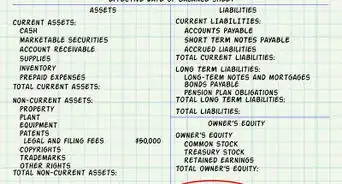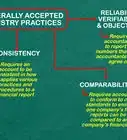This article was co-authored by Michael R. Lewis. Michael R. Lewis is a retired corporate executive, entrepreneur, and investment advisor in Texas. He has over 40 years of experience in business and finance, including as a Vice President for Blue Cross Blue Shield of Texas. He has a BBA in Industrial Management from the University of Texas at Austin.
There are 18 references cited in this article, which can be found at the bottom of the page.
This article has been viewed 59,876 times.
An annual report is a document that summarizes a company's performance and progress during the previous year. These reports are generally read by shareholders and investors, but they are also of interest to future lenders, people considering future employment with a company, and business students. Reading an annual report provides an overview of the company, familiarizing yourself with company leadership, and carefully reading financial information.
Steps
Accessing an Annual Report
-
1Decide what type of annual report you want. The annual report could be an official document – the 10-K required by the Securities and Exchange Commission – or a less formal report distributed to shareholders and company insiders.[1] While there is no universal format for annual reports, they usually contain the same basic components, including information about management and directors, financial data, projections on future growth, and market analysis.
-
2Get a company’s annual report. If you own stock in a publicly traded company, the annual report should be mailed to you. You can also find a company's annual report on its official website. If you want to read the annual report of a private company, however, you must ask and receive permission from the company, which will also provide the report if approved.[2]
- Private company annual reports are not generally held to the same standards as public companies, including the requirement to have audited books.
Advertisement -
3Get a 10-K. While not every company puts out an annual report, all public companies must file a 10-K annually. The U.S. Securities and Exchange Commission (SEC) website has a database which allows you to search for and download a public company's official annual report. Check out http://www.sec.gov/edgar/quickedgar.htm for more information and to locate the annual report of the company whose annual report you want to read.[3]
Getting an Overview of the Company
-
1Read the letter from the chairperson.[4] [5] The letter from the chairperson of the Board of Directors or the CEO of the company is the opening section of an annual report. It typically gives a broad overview about the company’s fortunes over the past year. The chairperson may also address problems and issues that arose, and outline what has been or will be done to solve these problems. Finally, the letter should also discuss future goals.
- Look for specific, clear plans for the company’s future.
- An analysis of the company’s gains and losses over the preceding year comprises the bulk of the chairperson’s letter.
-
2Read the business description. To learn more about the company and what exactly it does, read the business description, which is usually part 1. This will describe the company's offerings and its industry. It will generally also include brief descriptions of their business sectors, including main products and services, sources of materials, and the status of new products. This should be your starting point as you read the annual report, particularly if you're unfamiliar with the company.[6]
- This section may also include industry trends, both favorable and unfavorable.
-
3Look over the list of directors and officers of the company.[7] [8] This section might give short biographies of the individuals sitting on the board and company officers like the President or CEO. This section is intended to celebrate the hard work of the company’s personnel, as well as inspire confidence in investors and shareholders.
- Compare the current year’s list of directors and officers to those of prior years. If the list changes significantly year to year, it could be an indication of continuing company problems.
-
4Look over the ten-year summary. The ten-year summary analyzes where the company is financially compared to where it was every year for the past ten years.[9] This section will give you a good idea of what the long-term growth trends have been, as well as where the company might be headed in the future.
- If the company has not been around for ten years, the report might feature a similar section on “long-term growth” or a “five-year summary.”
-
5Check out the risk factors.[10] One of the areas in which the regular shareholder’s report and the official government annual report (form 10-K) differ is that the latter requires a risk assessment. These can be instructional for potential investors or stockholders, since the factors addressed in the risk assessment provide information about how financial projections might differ from actual results if certain conditions are met (or not met).
- Most companies list standard risks like an inability to maintain brand value and the threat of legal proceedings.
- Other risks, however, are more specific to the company. An oil and gas company might, for instance, list risk factors like changing technology, levels of oil and gas reserves, and corporate assumptions about energy consumption as risk factors.
- Risk factors shed light on how companies think and arrive at their outlook statements and financial projections.
- Risk factors are generally expansive and designed to protect the company in the event they occur, no matter how unlikely. You must determine for yourself the likelihood of a negative event occurring and its actual impact on the company.
-
6Read the management discussion. Management discussion and analysis is the section in an annual report that gives the management team an opportunity to voice their views on the company's financial trends. They will discuss both how the company performed over the past year as well as where they see the company headed in the future.[11]
- Management discussion will usually address the company’s debt and equity structure in addition to financial indicators like income and sales trends.
- Don’t blindly take the management discussion at face value. Hopefully, the company will have competent management, but if it does not, the opinions presented in the management discussion portion may not be accurate. The management statements are not vetted by independent CPAs.
-
7Review the sales and marketing section. This section discusses the products and services the company provides.[12] After reading this portion of the report, you’ll be able to understand what products and services the company is handling well and which are flagging.
- This section might contain information about company slogans and why they work to promote the brand.[13]
- The sales and marketing section should explain the key concepts associated with the product or service, and how the marketing department has employed them. For instance, a car maker might state that “youth, speed, and adventure” are the main themes behind its marketing campaign.
-
8Read about the company’s holdings.[14] Subsidiaries, brands, and addresses where the company has offices or plants will be listed here. Read the section to discover more about the various locations where the company does business, and what its acquisitions or holdings look like. The specific products a company produces or develops will each be described here.
- If the company has several major divisions or holdings, each will be reviewed. For instance, a company like Disney might talk about sales and performance of Marvel, Star Wars, ABC, and ESPN, all of which are brands or companies under its corporate umbrella.
Evaluating Financial Performance
-
1Read the letter of certified public accountant (CPA) opinion. The CPA opinion is the portion of the document where an independent CPA analyzes the company’s financial status.[15] Without a CPA opinion, the annual report is a far less reliable and objective document.
- In addition to financial records, the CPA’s opinion is based on a review of tangible assets and documents like purchase orders and contracts. He or she will have also collected information from banks, customers, and suppliers that the company dealt with.
- Accounting records must comply with U.S. Generally Accepted Accounting Procedures (US GAAP), which is a set of accounting practices that all public companies in the United States must adhere to.
-
2Review the financial statements.[16] The financial statement of an annual report is the most critical part of the document.[17] It includes the company's financial performance statistics, balance sheet, income statements, and cash flow statement. You need to look at each when reviewing a company to get a full picture.
- The income statement will show how much money the company took in. Both investment income and income from sales of products and services will be included here, as well as expenses incurred to reduce the revenues within the same period.
- The cash flow statement will show the company's starting cash balances at the start of the period, the sources and uses of cash during the period, and the ending cash balance. It might show, for instance, the company is investing in new plants, raw materials, property, or personnel.[18]
- The balance sheet shows the company's assets and liabilities as well as the owner's equity (the difference between assets and liabilities) on close of a specific date.
- When reading the annual report, pay special attention to the footnotes in the financial statement portion of the report because they may reveal additional details about the company's operations and properties.[19]
-
3Review the stock price history. The stock price history illustrates how the company's stock value has fluctuated over the course of the past year. It will usually be presented as a graph, along with an explanatory section offering analysis of the stock’s trends. The company's stock symbol and stock exchange listing are also listed in this section.[20]
- Compare the stock price of the company with others within its industry. Look for similarities and differences between the companies. If the stock price of the company decline much lower than those of other companies in the same industry, or did not rise as much, this variation may have been a result of mismanagement.
Reading for Red Flags
-
1Look out for companies with changing messages.[21] If a company is devoted to creating healthy customers one year and selling soda and candy the next, something may be wrong with its management and leadership. A close read of the chairperson’s opening statement will give you a good idea of what the company’s values and vision are from year-to-year.
- While it might be normal for a company to tweak their message over time -- for instance, by targeting modern, fashionable consumers, then by narrowing in on fashionable, trendy consumers who are on-the-go -- companies that move too far from their successful market niche might be in trouble.
- A company that takes on an entirely different target audience or seems to be overextending itself should be avoided.[22] For instance, a company that states it wants to make the best computers one year, then wants to make the best toothpaste the next year is probably not
-
2Beware of changing accounting practices.[23] If, for instance, a company suddenly tallies up a large impairment charge (a reduction on the balance sheet due to a loss of goodwill), you should be worried why the company’s goodwill has diminished. Similarly, a large decline in inventory could indicate that the company is overpaying for materials or personnel, and might be mismanaged.
-
3Read the proxy statement.[24] The proxy statement, or proxy, is an attachment to the official 10-K form that shows how much the company’s executives are being paid. It also gives information relevant to a the company's owners (shareholders) who are about to take a vote affecting the company.
-
4Look for actual, not adjusted, earnings. Adjusted earnings are the earnings a company expected or would have earned had extraordinary misfortunes, special events, or extraordinary circumstances not occurred. Instead, check what the company actually earned and review previous reports to confirm that the event was extraordinary. A large gap between the adjusted and actual earnings suggests that the company has run aground.
- Similarly, check the company’s expectations against reality. If a company’s annual report states an expectation to grow by 10% in the next year, but instead loses 5% of its value over the course of the year, finding an answer for discrepancies as they can be caused by a variety of events, including stock fraud.
References
- ↑ https://www.sec.gov/answers/form10k.htm
- ↑ http://www.dummies.com/how-to/content/reading-an-annual-report.html
- ↑ http://www.sec.gov/edgar/quickedgar.htm
- ↑ http://www.dummies.com/how-to/content/reading-an-annual-report.html
- ↑ http://www.investopedia.com/articles/basics/10/efficiently-read-annual-report.asp
- ↑ http://www.investopedia.com/articles/basics/10/efficiently-read-annual-report.asp
- ↑ http://www.dummies.com/how-to/content/reading-an-annual-report.html
- ↑ http://www.inc.com/encyclopedia/annual-reports.html
- ↑ http://www.dummies.com/how-to/content/reading-an-annual-report.html
- ↑ http://www.cnbc.com/2014/01/27/how-to-read-a-10-k-like-warren-buffet.html
- ↑ http://www.investopedia.com/terms/m/mdanalysis.asp
- ↑ http://www.dummies.com/how-to/content/reading-an-annual-report.html
- ↑ http://annualreport2014.volkswagenag.com/group-management-report/sustainable-value-enhancement/sales-and-marketing.html
- ↑ http://www.dummies.com/how-to/content/reading-an-annual-report.html
- ↑ http://www.dummies.com/how-to/content/reading-an-annual-report.html
- ↑ http://www.dummies.com/how-to/content/reading-an-annual-report.html
- ↑ http://www.inc.com/encyclopedia/annual-reports.html
- ↑ http://www.moneychimp.com/articles/financials/fundamentals.htm
- ↑ http://www.cnbc.com/2014/01/27/how-to-read-a-10-k-like-warren-buffet.html
- ↑ http://www.dummies.com/how-to/content/reading-an-annual-report.html
- ↑ http://www.cnbc.com/2014/01/27/how-to-read-a-10-k-like-warren-buffet.html
- ↑ http://www.inc.com/guides/2010/11/how-to-maintain-brand-consistency-across-product-lines.html
- ↑ http://www.cnbc.com/2014/01/27/how-to-read-a-10-k-like-warren-buffet.html
- ↑ http://www.cnbc.com/2014/01/27/how-to-read-a-10-k-like-warren-buffet.html














































































